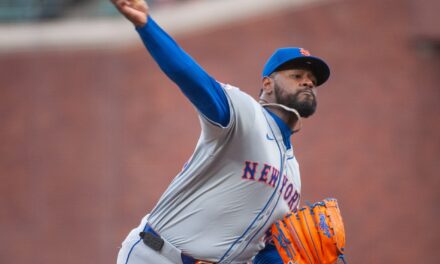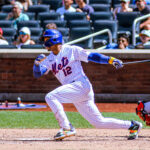
Stat Line: 1 IP, 0 R, 1 H, 0 SO, 0 BB
#MetsTwitter went wild last night seeing Tyler Clippard warming up for the ninth. After allowing a hard hit double off the bat of Abraham Almonte, Clippard settled down to produce three consecutive outs.
“I was anxious to get out there and put that first one under my belt,” Clippard said after the game.
Before the game, Clippard told reporters he believes the Mets have a better starting rotation than his former team, the Nationals, and added: “They’re beatable… There’s no perfect team in baseball.”
“I am really excited to be back in the NL East. National League baseball is my kind of baseball for sure and the Mets are right in the mix and it’s going to be a lot of fun chasing down my old teammates in Washington.”
“There is a lot of incentive there for me on a personal level and professional level to get the job done here in New York.”
In this article, I will breakdown Clippard’s changeup, the reason he will have more success pitching after the Mets starting rotation and his one pitching flaw.
Excellent Changeup
Clearly, Clippard’s out pitch is his changeup (See changeup thrown to Will Venable at-bat). Thrown at 12 to 15 mph slower than his fastball, Clippard is able to throw the baseball with almost the exactly same arm speed that he does with his fastball.
Additionally, Clippard is able to hide the baseball very well from the hitter, making his changeup even harder to pick up by the hitter. Clippard does this by keeping the baseball tucked behind his back hip and keeping his front shoulder closed to the hitter until the very last moment before throwing the baseball.
Changing Eye Level
Each Mets starting pitcher attribute’s their success this season to keeping the ball low in the strike zone, right around knee high. As a game progresses, opposing hitter’s eyes get trained to the low fastball. Although Clippard keeps the ball low in the strike zone, he shows the savvy veteran skill to utilize the upper area of the strike zone with his fastball.
Since Clippard will follow his teammates that primarily throw the baseball low in the strike zone and the general fact that it is a natural reaction for MLB hitters to swing at fastballs closer to their eyes, this skill will translate to a higher miss rate with his fastballs located up in the strike zone.
Two Pitches (Fastball and Changeup)
Like most relievers, Clippard only features two pitches in his repertoire. Given his excellent command and speed differential between his two pitches, his repertoire is nasty.
Concerning, are outings when Clippard can’t feel the command or create the movement in one of his two pitches. That scenario creates an uneven reliance on the stronger pitch. If picked up by the opposing team, this allows hitters to hunt for the stronger pitch since they too know Clippard will be relying on it.
Looking Forward
Clippard’s career stats to consider/expect:
- Very low HR/FB rate at 8.2% (league average is 10%) especially considering the low ground ball rate of 28%
- High strike rate at 9.94 K/9 coupled with a high walk rate at 3.73 BB/9
- Extremely low batting average against at .190
Stat of the Night
Thanks to @ESPNStatsInfo via @eliassports: Noah Syndergaard: 1st rookie to have 3 straight home starts of at least 8 IP, 1 R or fewer since Hideo Nomo, 1995 Dodgers
Follow Chris Zaccherio on Twitter @ziography for more Mets pitching insight that goes beyond statistics.















